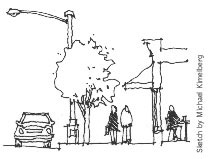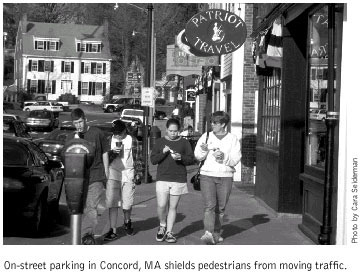55. On-Street Parking
 On-street
parking can be both a benefit and a detriment to pedestrians. On-street
parking does increase the "friction" along a street and can
narrow the effective crossing width, both of which encourage slower speeds;
parking can also provide a buffer between moving motor vehicle traffic
and pedestrians along a sidewalk. In addition, businesses reliant on on-street
parking are more geared to pedestrian access. This attention can foster
a more vibrant pedestrian commercial environment.
On-street
parking can be both a benefit and a detriment to pedestrians. On-street
parking does increase the "friction" along a street and can
narrow the effective crossing width, both of which encourage slower speeds;
parking can also provide a buffer between moving motor vehicle traffic
and pedestrians along a sidewalk. In addition, businesses reliant on on-street
parking are more geared to pedestrian access. This attention can foster
a more vibrant pedestrian commercial environment.
On the other hand, parking creates a visual barrier between motor vehicle traffic and crossing pedestrians especially with children. Therefore, where there is parking, curb extensions should be built where pedestrians cross. Parking needs to be cleared on the approaches to crosswalks.
At least 20 feet of parking should be removed on the approach to a marked or unmarked crosswalk and about 20 feet of parking should be removed downstream from the crosswalk. Some agencies require that parking be cleared back 30 to 50 feet from intersections for pedestrian safety reasons. Well-designed curb extensions can reduce these distances and increase the number of on-street parking spaces.

Purpose:
- Provides motorist access to destinations along a street.
- Aids in speed reductions by increasing friction along the street.
- Provides a buffer between side-walk edge and moving traffic.
Considerations:
- Parking may take up space desired for other uses, such as wider sidewalks or bicycle lanes.
- Approaches to crosswalks and intersections should be cleared and curb extensions added at crossing locations for pedestrian safety.
Estimated Costs:
$30–$150 per sign. Curb paint and stall marks or striping costs are additional (optional).